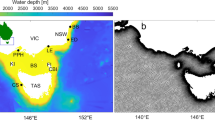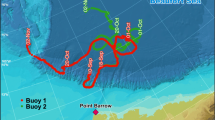Abstract
Sea ice can attenuate wave energy significantly when waves propagate through ice covers. In this study, a third-generation wave model called simulating wave nearshore (SWAN) was advanced to include damping of wave energy due to friction in the boundary layer below the ice. With the addition of an eddy viscosity wave-ice model, the resulting new SWAN model was applied to simulate wave height in the Bohai Sea during the freezing winter. Its performance was validated with available buoy data near the ice edge, and the new model showed an improvement in accuracy because it considered the ice effect on waves. We then performed a wave hindcast for the Bohai Sea during a freezing period in the winter of 2016 that had the severest ice conditions in recent years and found that the mean significant wave height changed by approximately 16.52%. In the Liaodong Bay, where sea ice concentration is highest, the change reached 32.57%, compared with the most recent SWAN model version. The average influence of sea ice on wave height simulation was also evaluated over a five-year (2013-2017) hindcast during January and February. We found that the wave height decrease was more significant in storm conditions even the eddy viscosity wave-ice model itself showed no advantage on damping stronger waves.
Similar content being viewed by others
Data Availability Statement
The data of the oceanographic buoys are provided by the North China Sea Marine Forecasting Center, SOA and are not publicly available. Other data used in this study are all provided in the references cited.
References
Amrutha M M, Kumar V S, Sandhya K G, Nair T M B, Rathod J L. 2016. Wave hindcast studies using SWAN nested in WAVEWATCH III-comparison with measured nearshore buoy data off Karwar, eastern Arabian Sea. Ocean Engineering119: 114–124, https://doi.org/10.1016/j.oceaneng.2016.04.032.
Battjes J A, Janssen J P F M. 1978. Energy loss and set-up due to breaking of random waves. In: Proceedings of the 16th International Conference on Coastal Engineering. ASCE, Hamburg, Germany, p.569–587.
Booij N, Ris R C, Holthuijsen L H. 1999. A third-generation wave model for coastal regions: 1. model description and validation. Journal of Geophysical Research: Oceans104 (C4): 7 649-7 666.
Cheng S K, Rogers W E, Thomson J, Smith M, Doble M J, Wadhams P, Kohout A L, Lund B, Persson O P G, Collins III C O, Ackley S F, Montiel F, Shen H H. 2017. Calibrating a viscoelastic sea ice model for wave propagation in the arctic fall marginal ice zone. Journal of Geophysical Research: Oceans122 (11): 8 770-8 793, https://doi.org/10.1002/2017JC013275.
Doble M J, Bidlot J R. 2013. Wave buoy measurements at the antarctic sea ice edge compared with an enhanced ECMWF WAM: progress towards global waves-in-ice modelling. Ocean Modelling70: 166–173, https://doi.org/10.1016/j.ocemod.2013.05.012.
Doble M J, De Carolis G, Meylan M H, Bidlot J R, Wadhams P. 2015. Relating wave attenuation to pancake ice thickness, using field measurements and model results. Geophysical Research Letters42 (11): 4 473–4 481, https://doi.org/10.1002/2015GL063628.
Eldeberky Y, Battjes J A. 1996. Spectral modeling of wave breaking: application to Boussinesq equations. Journal of Geophysical Research: Oceans, 101 (C1): 1 253–1 26
Gemmrich J, Rogers W E, Thomson J, Lehner S. 2018. Wave evolution in office wind conditions. Journal of Geophysical Research: Oceans123(8): 5 543–5 556, https://doi.org/10.1029/2018JC013793.
Hasselmann K, Barnett T P, Bouws E, Carlson H, Cartwright D E, Enke K, Ewing J A, Gienapp H G, Hasselmann D E, Krusemann P, Meerbur A, Müller P, Olbers D J, Richter K, Sell W, Walden H. 1973. Measurements of wind-wave growth and swell decay during the joint North Sea wave project (JONSWAP). Deutches Hydrographisches Institut, Hamburg. 95p.
Hasselmann S, Hasselmann K, Allender J H, Barnett T P. 1985. Computations and parameterizations of the nonlinear energy transfer in a gravity-wave specturm. Part II: parameterizations of the nonlinear energy transfer for application in wave models. Journal of Physical Oceanography, 15 (11): 1 378–1 39
Huang B G. 2009. Numerical simulation of waves in Bohai Sea and research on the influence of swells on wind waves. Ocean University of China, Qingdao, China. 67p. (in Chinese with English abstract)
Khon V C, Mokhov I I, Pogarskiy F A, Babanin A, Dethloff K, Rinke A, Matthes H. 2014. Wave heights in the 21 st century Arctic Ocean simulated with a regional climate model. Geophysical Research Letters41 (8): 2 956–2 961, https://doi.org/10.1002/2014GL059847.
Komen G J, Cavaleri L, Donelan M, Hasselmann K, Hasselmann S, Janssen P A E M. 1994. Dynamics and Modelling of Ocean Waves. Cambridge University Press, Cambridge, UK. 532p.
Komen G J, Hasselmann S, Hasselmann K. 1984. On the existence of a fully developed wind-sea spectrum. Journal of Physical Oceanography, 14 (8): 1 271–1 28
Li J K, Kohout A L, Shen H H. 2015. Comparison of wave propagation through ice covers in calm and storm conditions. Geophysical Research Letters42 (14): 5 935–5 941, https://doi.org/10.1002/2015GL064715.
Liu A K, Holt B, Vachon P W. 1991. Wave propagation in the marginal ice zone: model predictions and comparisons with buoy and synthetic aperture radar data. Journal of Geophysical Research: Oceans96 (C3): 4 605–4 621, https://doi.org/10.1029/90JC02267.
Liu A K, Mollo-Christensen E. 1988. Wave propagation in a solid ice pack. Journal of Physical Oceanography18 (11): 1 702–1 712.
Liu A K, Vachon P W, Peng C Y, Bhogal A S. 1992. Wave attenuation in the marginal ice zone during LIMEX. Atmosphere-Ocean, 30 (2): 192–206.
Lv X C, Yuan D K, Ma X D, Tao J H. 2014. Wave characteristics analysis in Bohai Sea based on ECMWF wind field. Ocean Engineering, 91: 159–171.
Meylan M H, Bennetts L G, Kohout A L. 2014. In situ measurements and analysis of ocean waves in the Antarctic marginal ice zone. Geophysical Research Letters41 (14): 5 046–5 051, https://doi.org/10.1002/2014GL060809.
Rogers W E, Thomson J, Shen H H, Doble M J, Wadhams P, Cheng S K. 2016. Dissipation of wind waves by pancake and frazil ice in the autumn Beaufort Sea. Journal of Geophysical Research: Oceans121 (11): 7 991–8 007, https://doi.org/10.1002/2016JC012251.
Serreze M C, Stroeve J. 2015. Arctic sea ice trends, variability and implications for seasonal ice forecasting. Philosophical Transactions of the Royal Society A: Mathematical Physical and Engineering Sciences373 (2045): 20140159.
Shi J, Wang P, Zhong Z, Zhang J. 2011. Comparison of ocean wave simulation with SWAN wave model using two kinds of computational grid in the Bohai Sea and the Yellow sea. Marine Forecasts28 (4): 48–57. (in Chinese with English abstract)
Squire V A. 2007. Of ocean waves and sea-ice revisited. Cold Regions Science and Technology49 (2): 110–133, https://doi.org/10.1016/j.coldregions.2007.04.007.
Stroeve J C, Serreze M C, Holland M M, Kay J E, Malanik J, Barrett A P. 2012. The Arctic’s rapidly shrinking sea ice cover: a research synthesis. Climatic Change110 (3–4): 1 005–1 027.
Tang M N, Liu Y, LI B H, Sui J P. 2012. Analysis of the sea ice long-term trend in the bohai sea and the northern yellow sea. Marine Forecasts29 (2): 45–49. (in Chinese with English abstract)
The SWAN team. 2018. Swan Scientific And Technical Documentation Swan Cycle III version 41.20AB. Delft University of Technology. http://swanmodel.sourceforge.net/. Accessed on 2019.3.28.
The WAMDI Group. 1988. The WAM model—a third generation ocean wave prediction model. Journal of Physical Oceanography, 18 (12): 1 775–1 810.
The WAVEWATCH-III Development Group. 2016. User manual and system documentation of WAVEWATCH III version 5.16. Tech Note 329 NOAA/ NWS/ NCEP/ MMAB College Park MD USA 326 pp.+ Appendices. https://polar.ncep.noaa.gov/waves/wavewatch/. Accessed on 2019.3.28.
Thomson J, Ackley S, Girard-Ardhuin F, Ardhuin F, Babanin A, Boutin G, Brozena J, Cheng S K, Collins C, Doble M, Fairall C, Guest P, Gebhardt C, Gemmrich J, Graber H C, Holt B, Lehner S, Lund B, Meylan M H, Maksym T, Montiel F, Perrie W, Persson O, Rainville L, Rogers W E, Shen H, Shen H, Squire V, Stammerjohn S, Stopa J, Smith M M, Sutherland P, Wadhams P. 2018. Overview of the arctic sea state and boundary layer physics program. Journal of Geophysical Research: Oceans123 (12): 8 674–8 687, https://doi.org/10.1002/2018jc013766.
Thomson J, Rogers W E. 2014. Swell and sea in the emerging Arctic Ocean. Geophysical Research Letters41 (9): 3 136–3 140.
Tolman H L. 1991. A third-generation model for wind waves on slowly varying, unsteady, and inhomogeneous depths and currents. Journal of Physical Oceanography21 (6): 782–797.
Wadhams P, Squire V A, Goodman D J, Cowan A M, Moore S C. 1988. The attenuation rates of ocean waves in the marginal ice zone. Journal of Geophysical Research: Oceans, 93 (C6): 6 799–6 818.
Wang R X, Shen H H. 2010. Gravity waves propagating into an ice-covered ocean: a viscoelastic model. Journal of Geophysical Research: Oceans115 (C6): C06024, https://doi.org/10.1029/2009JC005591.
Wang Z F, Dong S, Li X, Soares C G. 2016. Assessments of wave energy in the Bohai Sea, China. Renewable Energy90: 145–156.
Wang Z F, Wu K J, Zhou L M, Wu L Y. 2012. Wave characteristics and extreme parameters in the Bohai Sea. China Ocean Engineering, 26 (2): 341–35
Yin B S, Yang D Z, Sha R N, Cheng M H. 2005. Improvement of different source function expressions in SWAN model for the Bohai Sea. Progress in Natural Science15 (8): 720–724.
Zhang Y J, Jin B F, Feng X. 2007. Response of the sea ice conditions in the Bohai Sea to global climate change in the last over half century. Marine Science Bulletin26 (6): 96–101. (in Chinese with English abstract)
Zhao X, Shen H H, Cheng S K. 2015. Modeling ocean wave propagation under sea ice covers. Acta Mechanica Sinica31 (1): 1–15.
Author information
Authors and Affiliations
Corresponding author
Additional information
Supported by the National Key Research and Development Program of China (No. 2016YFC1402001) and the Fundamental Funds for the Central Universities (No. 201713026)
Rights and permissions
About this article
Cite this article
Yue, C., Li, J., Guan, C. et al. Surface wave simulation during winter with sea ice in the Bohai Sea. J. Ocean. Limnol. 37, 1857–1867 (2019). https://doi.org/10.1007/s00343-019-8253-3
Received:
Accepted:
Published:
Issue Date:
DOI: https://doi.org/10.1007/s00343-019-8253-3




